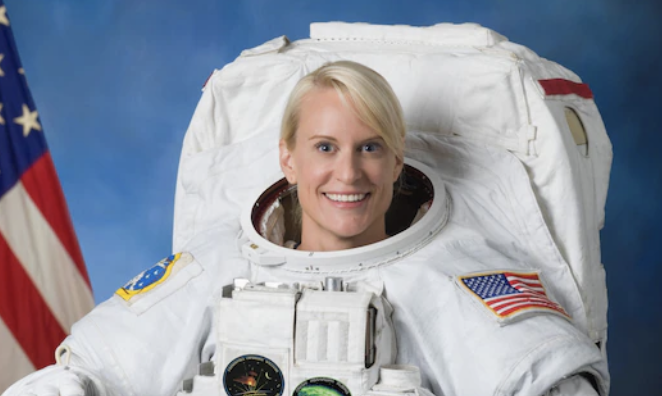

Army Reserve Maj. Kate Rubins was already an astronaut when she joined the Army, but was surprised to find that learning some of the basics of soldiering reminded her of trips to space.
“I was quite surprised when I was in my basic officer leadership course learning land navigation and thinking how helpful that would be when I’m an astronaut,” she said. “We don’t have satellite navigation around the moon. We don’t have magnetic fields or a compass, and so we are going to be using maps and terrain association and land navigation.”
Thursday, Rubins received the Basic Aviation Badge with Astronaut Device and Space Badge at a pinning ceremony at the Pentagon in Washington D.C.
The Astronaut Device on a flight wings is the rarest badge in the Army, awarded only to soldiers who have completed an operational space mission more than 50 miles above the earth (most airliners and military jets fly about 6 miles high, while the International Space Station is 250 miles up). The Basic Space Badge is awarded to soldiers who serve at least a year in space-related positions.
Rubin’s “stellar” resume is unique, having first been to space nearly a decade ago as a civilian before joining the Army. She was a crew member on the International Space Station and flight engineer during Expedition 48/49 in 2016 and again on mission 63/64 in 2020. During her time at NASA as a civilian astronaut, she worked with Army researchers and was the first to sequence DNA in space, according to the Army.
On her second flight aboard the ISS, Rubins decided she wanted to serve so when she returned earthside, Rubin was commissioned as an Army Reserve officer.
“I had always wanted to serve, and I was getting a little older,” she said. “I was coming up against the age deadline in order to sign up and to commission, and I thought when I got back to the planet, this was one thing that I really wanted to do.”
She also said learning “how to think clearly in a challenging situation” and working in small teams on a mission are applicable to both of her Army and NASA worlds.
Rubins said the astronaut device — which is the rarest badge awarded by the Army — is worn on the basic aircrew badge or the space badge. Officers are eligible for the device if they are in the Army and have flown in space on a government space mission with NASA.
“I learned about this when I was serving at NASA that this was something that was able to be awarded and so I’m very grateful,” Rubins said. “The device is nice and it’s a very nice recognition. The opportunity to serve every day is what I’m here for.”
According to an Army release, the award is authorized to personnel who complete at least one operational mission in space which is defined as 50 miles above earth. The device can be affixed to a soldier’s Army Aviator Badge, Flight Surgeon Badge or Aviation Badge.
She spent two and a half years preparing as an astronaut for her space mission and six months doing a mission.
“When you come from space and you land back on Earth, there’s actually kind of a period of what do I do now?,” she said, adding that when astronauts return they do physical rehabilitation and go back to working at NASA.
“The idea that I was going from one mission into the next mission was actually incredibly helpful,” she said.
Rubin’s three worlds
Rubin’s first milestone was getting her doctorate in cancer biology from Stanford University’s medical school. She then went on to work as a microbiologist.
Before commissioning and becoming a NASA astronaut, Rubins worked as a principal investigator at the Whitehead Institute for Biomedical Research in Cambridge, Massachusetts, leading 14 researchers in studies on viral diseases primarily affecting Central and West Africa, according to a NASA release.
Rubins said she also did molecular biology with Army Medical Research Institute of Infectious Disease at Fort Dietrich, Maryland studying bio threat agents and diseases like mpox and Ebola.
“I had a lot of experience working on the biologic side trying to come up with defensive countermeasures or vaccines for these viruses of concern,” Rubins said.
She now uses her medical and biology expertise as an officer with the 75th U.S. Army Reserve Innovation Command, focusing on synthetic biology and biodefense. Rubins said she looks at problems and solutions that are “biologically driven” which means her work involves finding modern techniques, adapting those for military purposes and keeping up on rapid changes in technology.
“Her unique blend of military experience and scientific acumen inspires future generations to pursue careers in science, technology, engineering and mathematics,” said Army Reserve Col. Nicholas Dille, commander, Support Group, 75th USARIC.
As one of a handful of people to hold military and civilian space flight credentials, Rubins also spoke about two of her Army mentors in space and on Earth: Col. Pat Forrester, who was chief of the astronaut office during her first flight and “made an indelible mark on the astronaut office,” and Col. Jeff Williams, her first space flight commander who taught her everything about “how to live in space,” and do research and maintenance on the ISS.
“A lot of that we can train on the ground, but you only get so far. You really need to learn that on orbit,” she said.
“Maj. Rubins is a stellar example of the Army’s core values and what it means to lead a life of service,” said Army Reserve Maj. Gen. Michelle Link, commanding general, 75th USARIC. “She inspires audiences around the world in her service as an astronaut and Army Reserve Soldier and is the embodiment of Twice the Citizen.”
